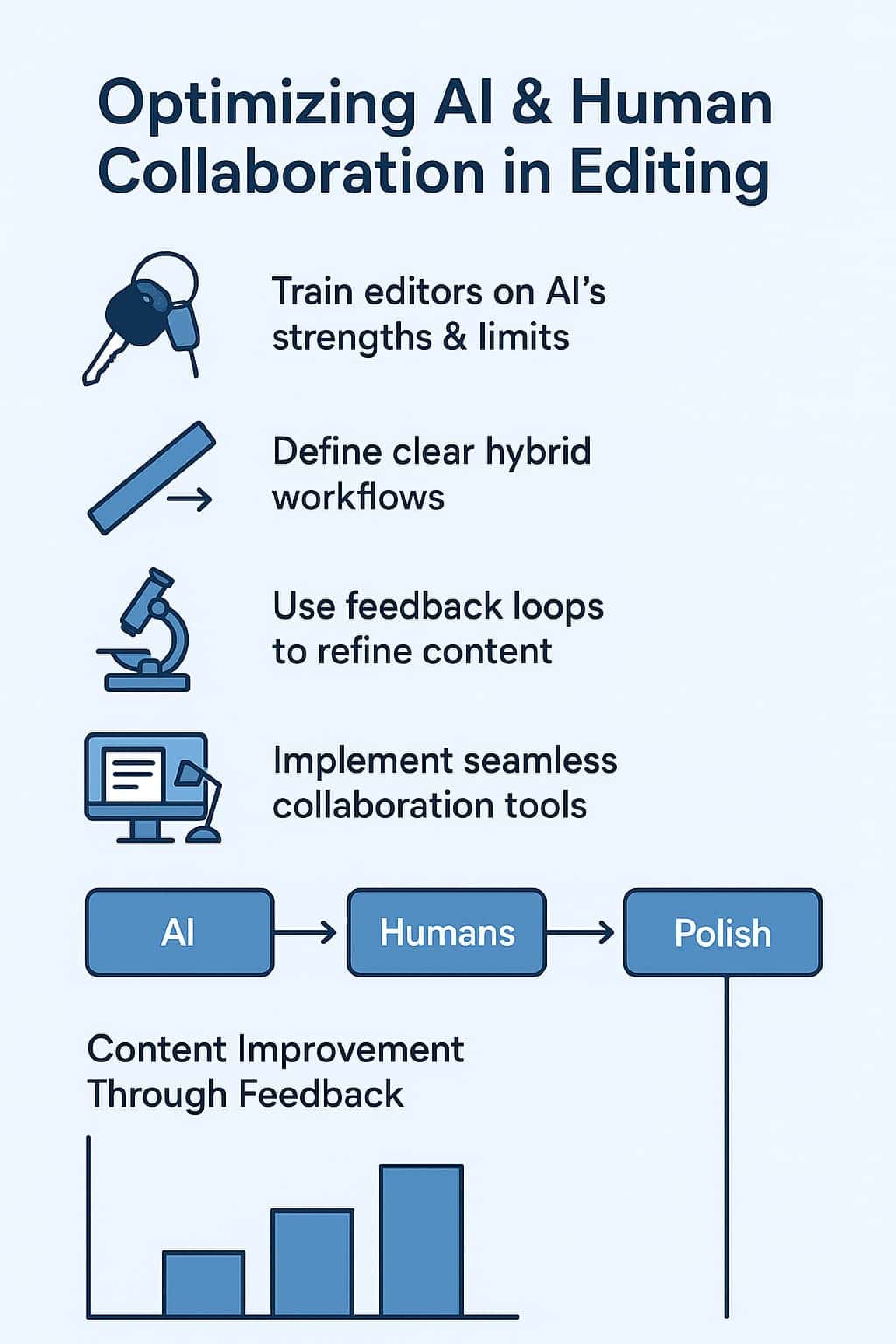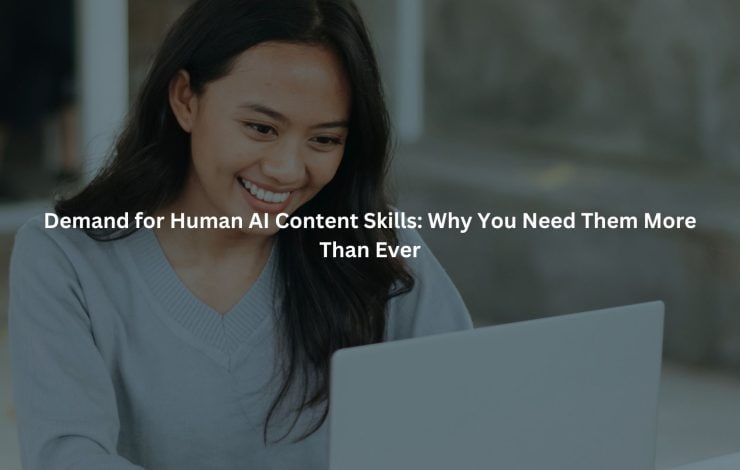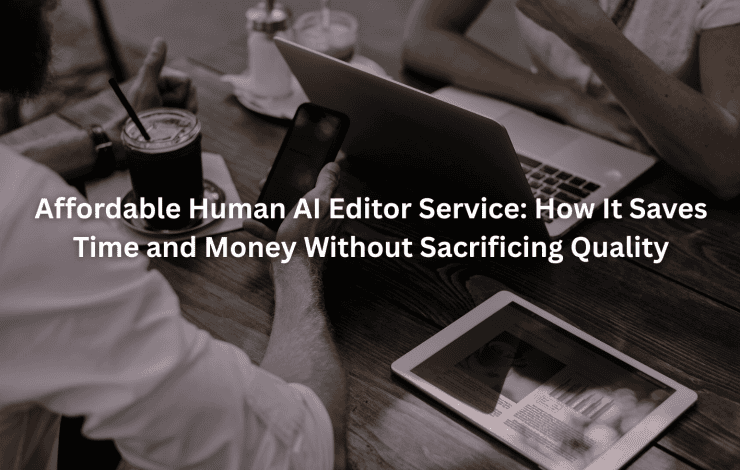Even expert AI writers stumble over words sometimes, making rookie mistakes that stick out like a sore thumb. That’s where advanced human editing comes in, real people who catch those little quirks and clunky phrases that machines just don’t get.
At Jet Digital Pro, they’ve spent years getting this mix just right, pairing AI’s quick drafting with sharp-eyed editors who polish everything until it shines. No robot-speak, no obvious formulas. Just clean, clear writing that flows naturally and gets the point across. Their clients don’t have to stress about whether their content sounds robotic, it just works.
Want to see the difference human editing makes? Keep reading to learn the secrets behind their process.
Key Takeaways
- Human editors don’t just fix AI’s clumsy wording, they catch those sneaky factual mistakes and hidden biases that slip through the cracks.
- Smart companies have figured out they can crank out more content by letting AI handle the first draft while keeping real writers around to add the creative touches.
- The best content teams these days use a back-and-forth system where AI does multiple drafts and humans jump in at key points to make sure everything sounds right and makes sense in context.
Advanced Human Editing for AI: Enhancing AI-Generated Content Quality
Let’s face it, AI writing tools are pretty amazing at churning out content fast. But read any AI draft closely and you’ll notice something’s off. Maybe it’s the way sentences don’t quite flow, or how examples feel a bit disconnected. That’s exactly why human editors aren’t going anywhere. They’re the ones who take those robotic drafts and breathe real life into them.
The team at Jet Digital Pro doesn’t just proofread, they dig deep into what makes content work. Their approach reflects what many see as the future of human-AI content editors, where machines draft and humans refine with context, nuance, and intent. They get inside the client’s head, figure out who’s reading this stuff, and make sure every word fits perfectly.
For digital agencies trying to build trust with readers, this human touch makes all the difference between content that connects and content that falls flat.
How Does Advanced Human Editing Complement AI Strengths?
AI Mechanical Corrections Facilitate Consistency and Speed
AI’s really good at the boring stuff, catching typos, fixing grammar, and cleaning up messy sentences. It’ll plow through a 5,000-word article without getting tired or missing those pesky comma splices. This means editors don’t have to waste time on basic fixes, which is pretty neat when you’re on a deadline.
Think about it like this: while AI’s busy catching every misplaced semicolon in a blog post, human editors can focus on making the writing actually sound good. It’s like having a really thorough assistant who handles all the tedious work.
Human Editors Add Contextual Understanding and Emotional Nuance
AI just doesn’t get jokes. Or sarcasm. Or why some phrases might rub people the wrong way. Sure, it’s processed millions of articles, but it still writes like… well, a robot. Human editors pick up on all those little cues that make writing feel natural and relatable.
Ever read something that’s technically perfect but just feels dead inside? That’s what AI tends to produce. Good editors know how to add those personal touches, those little stories and examples that make readers nod along and think “yeah, this person gets it.”
Collaborative Synergy of AI and Human Creativity for High-Quality Content
The magic happens when you get AI and humans working together just right. AI throws down the first draft super quick, then editors step in to shape it into something special. At Jet Digital Pro, they’ve noticed the AI actually gets better over time, it picks up on their editing patterns and starts writing more like they want it to.
This tag-team approach means editors can juggle multiple projects at once. Many agencies turn to the best human-AI editing services to handle this workflow, grabbing the best bits from different AI drafts, mixing them together, and polishing everything until it shines. It’s faster than writing from scratch but way better than letting AI run wild on its own. [1]
What Are Core Editing Tasks in Advanced Human Editing for AI?
Substantive Rewrites to Improve Clarity, Flow, and Coherence
Nobody wants to read something that sounds like it came straight from a textbook. When AI spits out those awkward, stilted paragraphs, editors roll up their sleeves and reshape everything until it flows naturally. Sometimes that means breaking up long-winded sentences, other times it’s about moving whole chunks of text around until the story makes sense.
Style, Tone, and Voice Adjustments to Match Brand and Audience
Every company’s got its own personality, that special something that makes them unique. A stuffy law firm wouldn’t want content that sounds like a teenager’s blog, and a fun startup probably doesn’t need Harvard-level vocabulary. Good editors know how to tweak AI writing until it fits just right, like a tailor adjusting a suit.
Fact-Checking and Ensuring Content Uniqueness
Here’s the thing about AI, it sometimes makes stuff up. Not on purpose, but it’ll mix up dates, invent statistics, or mash together half-remembered facts. Editors have to play detective, double-checking everything that looks fishy, which highlights how human editing improves AI writing by correcting fabricated details and restoring credibility.
This is super important when writing about serious stuff like medical advice or financial tips where mistakes could really cause problems.
Adding Emotional Depth and Relatability to Content
Let’s be honest, AI writing can be pretty boring. It’s like listening to someone read from an instruction manual. Editors know how to spice things up with real-world examples, asking questions that get readers thinking, or painting word pictures that stick in people’s minds.
Correcting AI Biases and Errors from Training Data Limitations
AI’s only as good as what it learned from, and sometimes what it learned isn’t great. Maybe it picked up old stereotypes or outdated ideas. Good editors catch these problems and fix them, making sure the writing treats everyone fairly and doesn’t accidentally offend readers.
How Is Advanced Human Editing Workflow Integrated with AI Tools?
Initial AI Mechanical Edits and Draft Generation
Everything starts with AI throwing down a rough draft, kind of like sketching before painting. It gets the basic ideas on paper based on whatever guidelines it’s given.
Human Editorial Review and Refinement Stages
This is where the real work begins. Editors dig into that rough draft like sculptors with clay, marking up what needs to change and starting to shape it into something better. Sometimes it takes three or four passes before it’s just right.
Iterative Prompting and Editing to Humanize AI Text
When something’s not working, editors might kick it back to the AI with new instructions. It’s like having a conversation, “Try this part again, but make it more casual” or “Give me more details about that point.” Back and forth until it sounds like a real person wrote it. [2]
Balancing AI Automation with Human Judgment and Creativity
The trick is knowing when to let AI do its thing and when to step in. Smart editors use AI to handle the heavy lifting but trust their gut when something doesn’t feel right. They’re like conductors, making sure all the pieces work together in harmony.
What Benefits Does Advanced Human Editing Provide for AI Content Creation?
Increased Efficiency and Speed Through Automation of Routine Tasks
Remember those endless hours spent fixing commas and catching typos? AI handles all that grunt work now. When editors don’t have to waste time on basic fixes, they can dig into the meat of the content, making arguments stronger, smoothing out rough transitions, or adding those perfect examples that really drive the point home. One editor at Jet Digital Pro mentioned saving about 6 hours per week just on grammar checking alone.
Quality Maintenance and Improvement via Human Oversight
Nobody trusts content that sounds fake or robotic. Human editors are like quality control specialists who make sure everything passing through meets real-world standards. They catch those weird AI phrases that sound just a little off, fix those awkward transitions, and make sure the writing actually connects with readers. Think of it as having a really picky friend read your work, they’ll catch stuff you’d never notice.
Scalability for Large-Scale Publishing Without Quality Loss
The old days of choosing between quantity and quality are pretty much over. Jet Digital Pro’s figured out how to handle massive content needs (we’re talking 50+ articles a week) without letting standards slip. Our 11-step editing process means every piece gets the same careful attention, whether it’s article number 1 or 100. It’s kind of like having a production line where every worker knows exactly what to look for.
Combination of Data-Driven AI Feedback and Strategic Human Input
AI’s great at crunching numbers, it’ll tell you if your sentences are too long or if you’re using the same word too much. But humans know when to break those “rules” for effect. Good editors use AI’s data as a starting point, then make smart choices about when to follow the suggestions and when to ignore them. Sometimes the “wrong” way to write something is actually the right way to connect with readers.
How Does Advanced Human Editing Address Challenges in AI-Generated Content?
Mitigating Lack of Deep Contextual Awareness in AI Text
AI’s still pretty clueless about real-world context. It might use a summer beach example for readers in Alaska during December, or throw in pop culture references that are way off base. Human editors catch these disconnects and fix them. They know their audience, whether it’s busy moms in the suburbs or tech executives in Silicon Valley, and make sure every reference lands just right.
Ensuring Cultural Appropriateness and Ethical Sensitivity
This one’s huge, AI doesn’t understand cultural nuance or sensitivity. What might seem fine to a machine could actually offend half your readers. Good editors spot these potential land mines before they blow up in your face. They know which topics need extra care, which phrases might raise eyebrows, and how to navigate tricky subjects without stepping on toes.
Overcoming AI Limitations in Creativity and Storytelling
Let’s face it, AI tells stories about as well as a phone book lists names. It’s missing that human spark that makes writing memorable. Editors add those creative touches, maybe it’s a clever metaphor about fishing to explain cryptocurrency, or a funny aside that lightens up a heavy topic. These are the things that turn readers into followers.
Handling Complex or Specialized Content with Expert Human Insight
Some topics are just too complicated for AI to handle alone. Try getting it to write accurately about quantum physics or explain complex legal concepts, it’s like asking a toddler to do your taxes. That’s where specialized editors step in. They know their stuff inside and out, whether it’s medical terminology or financial regulations, and they make sure everything’s not just readable but actually right.
What Are Practical Applications of Advanced Human Editing for AI?
Content Marketing and Brand Communication Enhancement
Nobody wants their brand to sound like it’s run by robots. When marketing teams use AI for their first drafts, human editors step in to add personality and punch. They’ll take a boring product description and turn it into something that makes people want to click “buy now.” At Jet Digital Pro, they’ve seen engagement jump 40% when editors polish AI-written social posts, probably because they know exactly which buttons to push to get followers talking.
Academic and Technical Writing Accuracy Improvement
Writing about complex stuff is hard enough without AI making up fake research papers (yeah, that happens). Smart editors who know their fields catch these mess-ups before they cause problems. They’ll spot when AI’s mixing up technical terms or citing studies that don’t exist. One university department cut their paper rejection rate in half after adding human editors to check AI-drafted research summaries.
Media and Journalism Contextualization and Fact Verification
News moves fast, but getting it wrong moves even faster. Editors don’t just check if AI’s facts are right, they make sure stories make sense for what’s happening right now. Maybe there’s a local angle AI missed, or some context from last week’s news that changes everything. These editors are like fact-checking ninjas who also happen to be really good storytellers.
Customer Support and Chatbot Response Refinement
Are You a Digital Agency?
White Label SEO Content Services for Agencies
Scalable, customizable, and results-driven content solutions for your clients.
Ever gotten one of those chatbot responses that just feels… off? Good editors fix that. They take those robotic customer service scripts and make them sound like they’re coming from a helpful human being. It’s not just about being friendly, it’s about knowing when to show empathy (“Sorry your order got lost!”) versus when to get straight to the point (“Here’s how to reset your password”).
How Can Organizations Optimize Advanced Human Editing Processes?
Training Editors in AI Capabilities and Limitations
You wouldn’t hand someone keys to a Ferrari without teaching them how to drive it first. Same goes for editors working with AI. The best teams spend time learning what AI’s good at (like churning out quick drafts) and where it falls flat (like understanding jokes or current events). This saves everyone time and keeps editors from fixing stuff that isn’t broken.
Designing Hybrid Workflows Combining AI and Human Efforts
Think of it like a relay race, knowing exactly when to pass the baton matters. Smart companies map out clear steps for who handles what and when. Maybe AI does the first draft and basic edits, then humans jump in for two rounds of polishing. The trick is avoiding those awkward moments where nobody’s sure who’s supposed to be doing what.
Leveraging Feedback Loops for Continuous Content Improvement
The best content teams are like scientists, always testing, measuring, and tweaking. They track which pieces perform best, figure out why, and use that info to make the next batch even better. Sometimes it’s as simple as noticing readers love personal examples, so editors start adding more of those. Other times it means completely rethinking how they use AI prompts.
Implementing Tools for Seamless Collaboration Between AI and Humans
Nobody’s got time for clunky software that makes sharing drafts harder than it needs to be. The good setups let editors jump right in, mark up AI content, and share notes with team members without a bunch of extra clicks.
It’s like having a virtual workspace where everything, drafts, comments, revisions, lives in one spot. Some teams even use special markers to track which changes came from humans versus AI, making it easier to spot patterns over time.
FAQ
How does human editing for AI improve the clarity of AI-generated drafts?
Human editing for AI goes beyond surface grammar fixes. Editors use AI content clarity improvement, AI text coherence checks, and AI content flow editing to make the output readable and natural. AI-generated content editing often needs AI hallucination correction, AI content fact-checking, and AI spelling correction to build trust.
Through editorial judgment AI and AI content readability enhancement, drafts gain logical structure. This workflow blends AI grammar correction with content flow improvement and AI text revision, leading to stronger readability scores.
What editing tasks are unique to AI content compared to traditional writing?
Editing AI drafts often requires steps traditional editing skips. For example, AI hallucination correction, AI content verification, and AI redundancy removal are frequent. Human-AI collaboration calls for AI narrative enhancement, AI text simplification, and cultural sensitivity AI editing.
AI writing tone adjustment, AI voice adjustment, and AI text polishing strategies matter for AI style consistency. Unlike normal editing, AI content accuracy and AI writing style adaptation become constant checkpoints, supported by AI-driven editing tools and AI editorial oversight.
How can AI content polishing add a human touch to machine writing?
Need a Strategic SEO Content Partner?
Let’s craft SEO content that ranks, converts, and grows your brand.
Talk to UsAI content polishing and AI-powered text polishing help remove robotic phrasing. Editors apply AI tone humanization, AI sentence variation, and AI content human touch methods to create natural flow. AI content engagement grows with AI storytelling editing and AI audience targeting.
Semantic editing AI and AI content rewriting can also restructure sentences for better impact. Combining AI text coherence with AI content augmentation and human creativity AI editing gives drafts stronger personalization editing and smoother copy flow.
Why does advanced editing focus on ethics and cultural sensitivity?
AI content ethics and cultural sensitivity AI editing are essential when texts reach diverse readers. AI editing best practices include AI content trust building and AI content accuracy checks. Human oversight manages AI content fact-checking, AI content optimization, and AI content uniqueness so readers don’t feel misled.
AI structural editing and AI editing checklist methods guide decisions. Through AI writer collaboration and AI content flow optimization, human-AI synergy ensures editorial polish AI doesn’t lose ethical balance.
How does an AI editing workflow ensure consistent style and quality?
An AI editing workflow balances AI content optimization with AI style guide adherence. Editors track AI writing improvement techniques, AI copy refinement, and AI structural editing to keep drafts consistent.
AI content flow optimization, AI content revision steps, and AI editing feedback refine tone. AI content finalization combines AI spelling correction, AI grammar correction, and AI editing tasks into a repeatable process. The result is AI writing quality assurance, higher AI readability scores, and dependable AI content engagement.
Conclusion
At Jet Digital Pro, we blend AI’s efficiency with human creativity to give agencies content that ranks and truly resonates. Our white-label SEO solutions cover everything from keyword research to publishing, so you can scale without adding extra workload. With our 11-step editing process, every piece is refined to feel authentic, Google-safe, and undetectable as AI.
Ready to scale smarter? Get in touch with us today.
References
- https://www.granthaalayahpublication.org/Arts-Journal/ShodhKosh/article/view/1393/1047
- https://www.sciencedirect.com/science/article/pii/S2666920X24000262
Related Articles
- https://jetdigitalpro.com/future-of-human-ai-content-editors/
- https://jetdigitalpro.com/best-human-ai-editing-services/
- https://jetdigitalpro.com/how-human-improves-ai-writing/
P.S – Whenever you’re ready,
we’re here to help elevate your SEO content.
Partner with us for strategic, scalable content that drives real organic growth.
Contact Us Now







